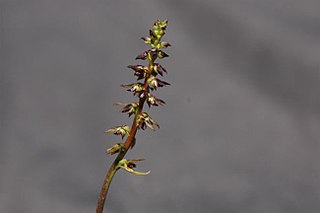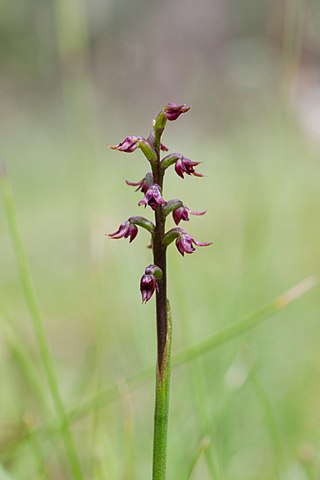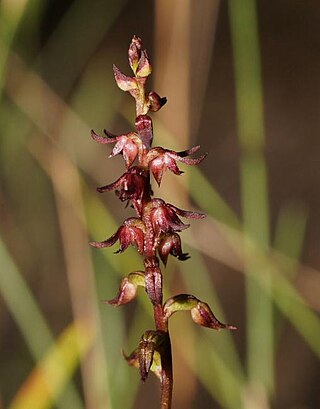
Genoplesium plumosum, commonly known as the Tallong midge-orchid or plumed midge-orchid, is a species of orchid endemic to New South Wales. It is a small orchid only known from a few sites near the towns of Tallong and Wingello on the Southern Tablelands and is only relatively easy to find for about a month, when it flowers. It has been classified as "Endangered" under the EPBC Act.

Genoplesium commonly known as midge orchids, is a genus of about 50 species of flowering plants in the orchid family, Orchidaceae and is found in Australia, New Zealand and New Caledonia. Midge orchids are terrestrial herbs with a single leaf at the base of the plant. They are similar to orchids in the genus Prasophyllum in that plants without flowers have a hollow, onion-like leaf. The flowers are small but often scented and attractive to their insect pollinators. There is disagreement about which species belong to this genus and some taxonomists suggest that most belong in the genus Corunastylis.
Prasophyllum rogersii, commonly known as the Barrington Tops leek orchid is a species of orchid endemic to New South Wales. It has a single tubular leaf and up to twenty five reddish-brown flowers and only occurs in a few locations at higher altitudes.

Genoplesium nudum, commonly known as the tiny midge orchid in Australia or the red midge orchid in New Zealand, is a small terrestrial orchid native to south-eastern Australia and New Zealand. It has a single thin leaf fused to the flowering stem and up to forty small, reddish-purple or green and red flowers. Australian and New Zealand authorities use the name Corunastylis nuda but Genoplesium nudum and Prasophyllum transversum are used by the World Checklist of Selected Plant Families.
Genoplesium rufum, commonly known as the rufous midge-orchid, is a species of orchid endemic to New South Wales. It has a single thin, wiry leaf and up to twenty five drooping, pinkish or reddish flowers on a flowering stem which is fused to the lower part of the leaf. It was formerly thought to range from Queensland to South Australia and Tasmania but specimens in other states are now assigned to Genoplesium clivicola.

Genoplesium nudiscapum, commonly known as the bare midge orchid, is a species of small terrestrial orchid endemic to Tasmania. It has a single thin leaf fused to the flowering stem and up to twenty small, green and reddish-brown flowers. It was thought to be extinct, since it had not been seen since 1852 but was rediscovered in 2008. The species has also been described as occurring on continental Australia. The species is known as Corunastylis nudiscapa in Tasmania.

Genoplesium filiforme, commonly known as the glandular midge orchid is a small terrestrial orchid endemic to the east coast of Australia. It has a single thin leaf and up to thirty greenish to purple flowers with a reddish-purple labellum. The edges of its flower parts are covered with many short glandular hairs. It is found from southern Queensland to southern New South Wales.

Genoplesium morrisii, commonly known as the bearded midge orchid and known as Corunastylis morrisii in Australia, is a small terrestrial orchid endemic to south-eastern Australia. It has a single thin leaf fused to the flowering stem and up to fifteen small, dark purplish-black or green and purple flowers.
Genoplesium littorale, commonly known as the Tuncurry midge orchid, is a species of small terrestrial orchid endemic that is endemic to New South Wales. It has a single thin leaf fused to the flowering stem and up to thirty small green flowers with a purple-brown labellum. It is only known from fewer than two thousand plants in a small area on the New South Wales North Coast and is critically endangered.
Genoplesium parvicallum, commonly known as the mountain-top midge-orchid, is a species of orchid which is endemic to Queensland. It is a small orchid with up to twenty five greenish flowers with purplish brown marking and is only known from mountaintops in the McPherson Range. It is treated as Corunastylis parvicalla in Queensland.
Genoplesium pedersonii, commonly known as Pederson's midge orchid, is a species of small terrestrial orchid endemic to the Blackdown Tableland in Queensland. It has a single thin leaf fused to the flowering stem and up to thirty small, greenish red to reddish, self-pollinating flowers with a dark purplish red labellum. The species is treated as Corunastylis pedersonii in Queensland.

Genoplesium ruppii, commonly known as Rupp's midge orchid, is a species of small terrestrial orchid that is endemic to eastern Australia. It has a single thin leaf fused to the flowering stem and up to twenty five small, hairy green flowers with a purple labellum.
Genoplesium sagittiferum, commonly known as the horned midge orchid, is a species of small terrestrial orchid that is endemic to New South Wales. It has a single thin leaf fused to the flowering stem and up to ten small, yellowish-green flowers with a hairy reddish labellum.

Genoplesium laminatum, commonly known as the red midge orchid, is a small terrestrial orchid endemic to New South Wales. It has a single thin leaf fused to the flowering stem and up to twenty bright reddish flowers. It grows in heath and grassy forest in a few places on the South Coast and Central Tablelands.
Genoplesium trifidum, commonly known as the trifid midge orchid, is a small terrestrial orchid endemic to New South Wales. It has a single thin leaf fused to the flowering stem and up to twenty five dark purplish-black and green flowers. It grows in heath in scattered places in the Sydney basin.
Genoplesium carectum is a species of small terrestrial orchid endemic to a restricted part of New South Wales. It has a single leaf fused to the flowering stem and between three and thirteen brownish-green flowers with purple and red markings. It occurs in three populations in swampy places in and near Wollemi National Park.
Genoplesium cuspidatum is a species of small terrestrial orchid endemic to eastern Australia. It has a single leaf fused to the flowering stem and between 6 and 28 reddish to dark purple flowers with prominent darker stripes.
Prasophyllum obovatum is a species of small terrestrial orchid endemic to New South Wales. It has a single leaf fused to the flowering stem and a few reddish-purple flowers with translucent patches.
Genoplesium stephensonii, commonly known as Stephenson's midge orchid, is a species of small terrestrial orchid that is endemic to the south-east of New South Wales. It has a single leaf fused to the flowering stem and usually up to five green flowers with pink to reddish markings.
Genoplesium tenellum is a species of small terrestrial orchid that is endemic to eastern Australia. It has a single leaf fused to the flowering stem and between 5 and 21 green flowers with reddish-purple lines and markings.







